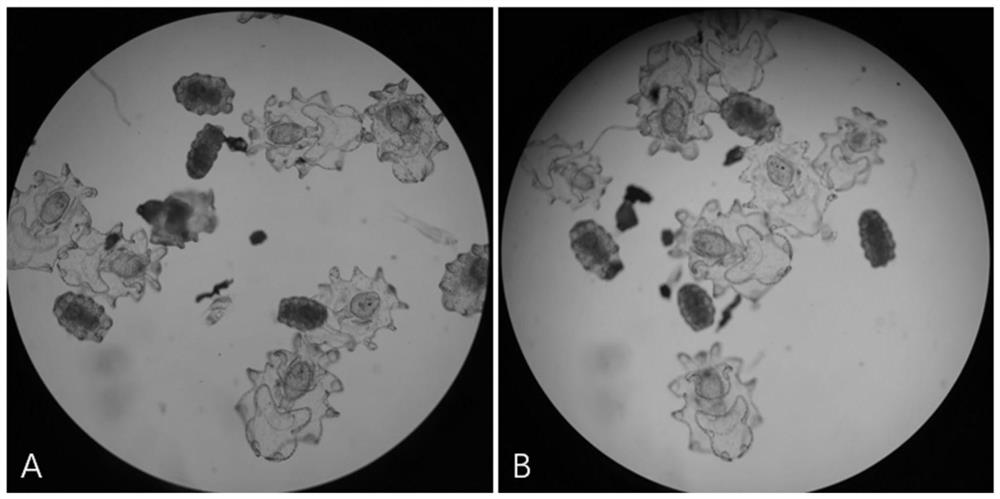Compound feed for breeding larvaeof tropical sea cucumbers in planktonic period and preparation method of compound feed
A technology of compound feed and larvae, which is applied in animal feed, animal feed, application, etc., can solve the problems of increasing labor and material costs, affecting the development process of sea cucumber larvae, and death of sea cucumber larvae, and achieves the effect of saving manpower
- Summary
- Abstract
- Description
- Claims
- Application Information
AI Technical Summary
Benefits of technology
Problems solved by technology
Method used
Image
Examples
Embodiment 1
[0016] A compound feed for cultivating planktonic larvae of tropical sea cucumber Yuzu and sea cucumber, the feed preparation method is as follows: 10 g of sargassum powder (Laizhou Haifu Feed Co., Ltd.), 200 mL of chilled sargassum algal liquid, and stable diatom seeds (Luoyang Yuyao Technology Co., Ltd.) 2g, chlorella powder (Dongtaici Centennial Bioengineering Co., Ltd.) 2g, yeast powder (Angel Yeast Co., Ltd.) 2g, mixed in 5L of clean seawater, put into a 500-mesh mesh bag, The filtrate is collected by filtration, which is the compound feed for cultivating the larvae of the tropical sea cucumber Yuzu sea cucumber in the planktonic stage. The preparation method of chilled fresh Sargassum algae liquid is as follows: freshly collected Sargassum algae, stored at -20°C, take 80g when using, add 80g of water, use a household grinder to crush to the smallest particle size, then add 2.0L of water, mix well, Store at 4 ℃, that is, chilled Sargasso algae liquid.
[0017] The prepar...
Embodiment 2
[0019] Set up a pond of Yuzu sea cucumber larvae experimental group with a water body of 30m 3 , each day at 8:00 am and 7:00 pm each feeding the compound feed in the above Example 1 once. One control pool of sea cucumber larvae was set up. The development stage and density of sea cucumber larvae were the same as those of the experimental group, and the water body was 30 m. 3 , feed fresh Chaetoceros algae once a day at 8:00 am and 7:00 pm according to the conventional method. After 21 days, the sea cucumber larvae in the experimental group and the control group were counted three times and averaged. The results showed that the density of larvae in the experimental group pond was 68±6 / L water body, and the density of larvae in the control group pond was 72±4 / L water body, and there was no significant difference between the two. Microscopic observation was carried out on the sea cucumber larvae in the experimental group and the control group, and the results showed that: the ...
Embodiment 3
[0021] A compound feed for cultivating planktonic larvae of tropical sea cucumber Apostichopus japonicus, the feed preparation method is as follows: 8 g of sargassum powder (Laizhou Haifu Feed Co., Ltd.), 150 mL of chilled sargassum algal liquid, and stable diatom seeds (Luoyang Yuyao Technology Co., Ltd.) 1g, chlorella powder (Dongtaici Centennial Bioengineering Co., Ltd.) 1g, yeast powder (Angel Yeast Co., Ltd.) 1g, mixed in 5L of clean seawater, put into a 500-mesh mesh bag, The filtrate is obtained by filtration, which is the compound feed for the planktonic larvae cultivation of A. japonicus. The preparation method of chilled Sargassum algae liquid is as follows: freshly collected Sargassum algae, stored at -20°C, take 50g when using, add 50g of water, use a household grinder to crush to the smallest particle size, then add 1.5L of water, mix well, Store at 4 ℃, that is, chilled Sargasso algae liquid.
[0022] The prepared tropical sea cucumber Apostichopus japonicus pla...
PUM
 Login to View More
Login to View More Abstract
Description
Claims
Application Information
 Login to View More
Login to View More - R&D
- Intellectual Property
- Life Sciences
- Materials
- Tech Scout
- Unparalleled Data Quality
- Higher Quality Content
- 60% Fewer Hallucinations
Browse by: Latest US Patents, China's latest patents, Technical Efficacy Thesaurus, Application Domain, Technology Topic, Popular Technical Reports.
© 2025 PatSnap. All rights reserved.Legal|Privacy policy|Modern Slavery Act Transparency Statement|Sitemap|About US| Contact US: help@patsnap.com

